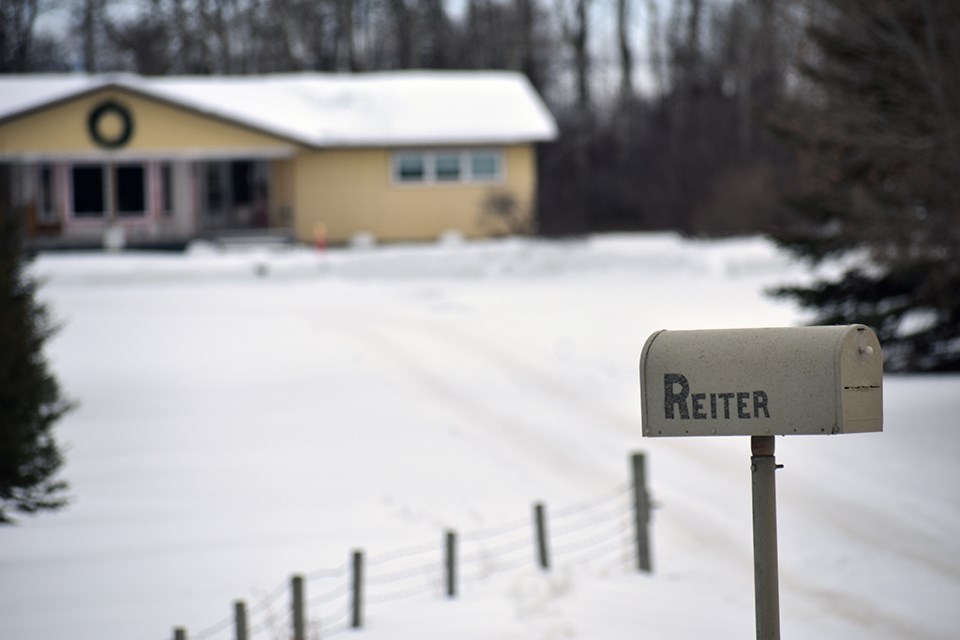MEOTA — Louise Reiter, Darwin Kobelsky and their neighbours living along the Iffley Hatherleigh Road north of the Battlefords are taking a stand against SaskPower’s plans to install power poles on their property.
But they fear their resistance will have no effect, as the Saskatchewan crown corporation, responsible for power in the province, can use Canada’s expropriation laws to overrule their protests.
At a meeting in Meota last fall, residents possibly affected by one of three proposed routes were told the new doubled-posted power poles were being installed to improve their flickering power, said the Iffley Hatherleigh Road neighbours.
“I don’t believe that for a minute … that’s been happening for the 29 years we’ve been there, and they’ve never done anything,” Louise Reiter told the News-Optimist/SASKTODAY.ca.
Reiter and her neighbours believe the new power pole installation is about serving the nearby heavy oil plant, not local residents.
“It’s for the oil plant … the main one, to the south. When this plant got built, SaskPower said that they could produce enough electricity to not cause any issues and not to worry about it,” Darwin Kobelsky said.
The nearby Meota East Facility is among a number of thermal plants acquired from Serafina Energy by Strathcona Resources Ltd. in September 2022, with the Saskatchewan government highlighting the possibility of expansions at their facilities.
SaskPower’s website says they’re working with the oil and gas company and that the new 138-kilovolt power line to connect a new substation to an existing power line in the area will run for six kilometres. Their website also says the new power line will add more distribution services to support Strathcona Resources’ oilfield operations in the Meota and Prince areas.
Kobelsky told the News-Optimist that the area experiences frequent power surges, which is reportedly costing the oil company money.
Of the three proposed routes, two go through wetlands. The last route. a direct line, is along the grid road for easy access, and is the most economical for SaskPower, but passes within 250 metres of five homes.
“They had three proposed routes, and they just came back to us in January here to say that they picked the final route, which is along here,” Kobelsky said, gesturing along the map highlighting an east-bound corridor along the Iffley Hatherleigh Road.
“Basically, they told me because it’s wetlands, it gets thrown out right away. They knew that when they made the map … they basically gave us one choice, they had that choice in mind and that’s what they wanted.”
At a meeting in early February, SaskPower tried to convince them there was no other option.
“Basically, they told us that, ‘it doesn’t matter,’ they expropriate the land eventually. So, basically, suck it up,” Kobelsky said.
“I thought this was a democratic country, that once you bought land, you owned it. Now if they can move in whenever they feel like it and take over, this is no longer a democracy. We may as well be communist China,” Reiter said.
Kobelsky feels they’re doing what’s cheapest and easier, not what’s best for people.
“At what cost, though? To us?” Reiter asked. “Human beings are more important than cattle or crops.”
Kobelsky and Reiter are both concerned about the possible adverse health effects possible from living so close to high-voltage power lines, noting that cutting the grass, having grandchildren playing in their yard, or even walking beneath the power lines puts them within the 46 metres SaskPower has told them they’d have to avoid.
“They say it’s safe with 46 metres for a buffer zone, but if you do any research on the internet, lots of this 46 meters stuff is from when they didn’t have a lot of studies … anything that I’ve read is 200 metres minimum. They do know it has caused leukemia in kids, cancer in adults, they just don’t know to what extent,” Kobelsky said.
They’re also worried about the devaluation of their property, with Reiter referencing two properties in West Park, Battleford, that she believes haven’t sold due to the presence of power poles on the property.
“We’re not going to be able to stay out here forever. At some point, we’ll probably have to move to a seniors’ home, and this was to be our retirement funds,” she said.
“These power lines that they’re talking about are double-posted. Apparently, the posts are 12 feet apart. That’s taking up a chunk of our land, and we own this land.”
“I’ve spoken to realtors, and power lines may affect anywhere from 10 to 30 per cent of the property value … that’s just the value, it also decreases the number of people that will want to buy the property,” Kobelsky said.
Reiter also noted that the government often calls on people to be mindful of their power consumption, so Reiter and her husband opted to plant a windbreak to avoid having to turn on the furnace as often and to limit their electricity usage.
Now, Reiter says, their windbreak and saskatoon berry bushes will be cut down or moved, with no guarantee that they could survive a transplant. The fence they paid for themselves and built will also be moved.
To counteract this, SaskPower has offered them $5,000 per installation. Not wanting to take it and accept the proposal, they’re also worried that they’ll end up with nothing as SaskPower threatens to take their land.
“If they do force us into that, what are the chances of getting any kind of money?” Kobelsky said.
“We keep insisting, but now, they’ve said that it doesn’t matter because they have the right of eminent domain,” Reiter said, referring to Canada’s expropriation law.
“We don’t get a say.”




